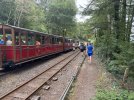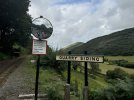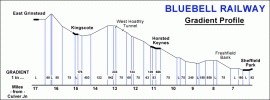The original Act of Parliament for opening the railway stipulated that there must be 4 trains a day in each direction, calling at Newick and Chailey, Sheffield Park, Horsted Keynes and West Hoathly. Barcombe and Kingscote weren’t mentioned, hence the permanent closure of these two stations in May 1955 when the line closed for the first time. The rest of the line reopened to passengers in August 1956, but closed again to passengers in March 1958 after two years of what was dubbed the ‘Sulky Service’.
The line through West Hoathly remained open until 1963, when the line was fully closed between East Grinstead and Horsted Keynes. At West Hoathly the track was still there until 1964, when ironically a Bluebell engine was drafted in to help lift the track. As mentioned above the station was fully demolished in 1967 by BR, not the Bluebell.
The station site was acquired in 1974 by the railway, and as mentioned above the planning permission for reopening that section of line stated that West Hoathly station should not reopen because of concerns over an increase in traffic on the local roads, which are quite narrow through West Hoathly and Sharpthorne. The line was opened as far as West Hoathly in 1992, with a simple runround loop installed. The loop was lifted when the Kingscote extension opened in 1994. The rumour about the pub is a well-known one on the railway!
If the Bluebell did apply for planning permission to reopen the station, they would likely get approval for it. Unfortunately, reopening the station exactly as it was is now impossible without changing the alignment of the railway, as new planning laws do not allow the construction of a railway station on a hill, and there is a relatively steep climb out of the northern tunnel portal.
The options currently are to not rebuild the station, carry out the groundwork necessary to level the trackbed and reopen it in the same location or move the station a few chains north where the trackbed is on a very shallow gradient that would be easier to level out.

en.m.wikipedia.org



